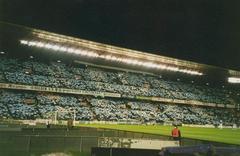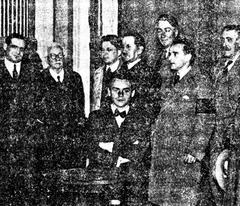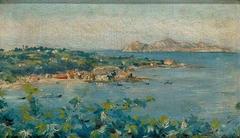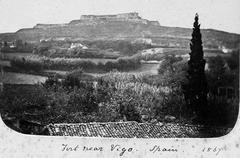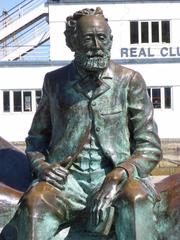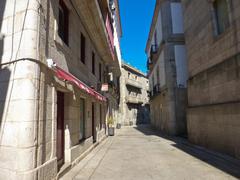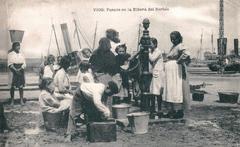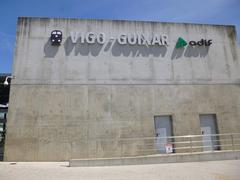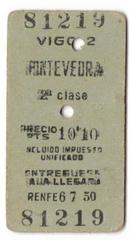
Virxe do Carme de Moaña: Visiting Hours, Tickets, and Historical Significance in Vigo, Spain
Date: 04/07/2025
Introduction
Nestled along the scenic coast of Galicia in northwestern Spain, the town of Moaña offers visitors a unique window into the region’s deep maritime heritage and vibrant cultural traditions through its devotion to the Virxe do Carme (Our Lady of Mount Carmel). Revered as the patroness of sailors and fishermen, the Virxe do Carme is central to Moaña’s identity, symbolizing protection, hope, and an enduring connection to the sea. Each July, the annual Fiestas del Carmen—centered around a revered statue by sculptor Xosé Rivas Rodríguez—draw locals and visitors alike for a blend of solemn religious observance and lively cultural celebration.
This guide provides comprehensive information for travelers and cultural enthusiasts seeking to experience the Virxe do Carme in Moaña. Here, you’ll find detailed historical context, insights into the festival’s artistic and religious significance, practical visitor information (including opening hours, ticketing, and accessibility), recommendations for nearby attractions, and tips for making the most of your visit. Whether you are drawn by history, faith, or the vibrant festival atmosphere, Moaña invites you to immerse yourself in one of Spain’s most cherished coastal traditions. (La Voz de Galicia; Morrazo.org; VenalMorrazo.com)
Table of Contents
- Historical Origins
- The Virxe do Carme Statue: Art and Visiting Hours
- Getting to Moaña
- Fiestas del Carmen: Program and Tips
- Nearby Attractions and Photographic Spots
- Cultural and Artistic Continuity
- Practical Information
- Religious Significance and Rituals
- Community Participation and Identity
- Frequently Asked Questions (FAQ)
- Visuals and Media
- Conclusion and Call to Action
- References
Historical Origins
The devotion to the Virxe do Carme in Moaña is entwined with the area’s fishing traditions and maritime past. Although the official designation of the Virgin as patroness of the Spanish Navy came by royal decree in 1901, records of devotion in Moaña trace back to at least the late 18th century, when a classic image of the Virgin and Child was donated in 1794. This image, now restored and kept in the Capela do Rosario, became a focus for the prayers of mariners and emigrants. Maritime tragedies in the early 20th century deepened the community’s devotion, inspiring the creation of new religious images and culminating in a tradition of annual festivities that remain central to Moaña’s identity. (Morrazo.org)
The Virxe do Carme Statue: Art and Visiting Hours
A highlight for visitors is the statue of the Virxe do Carme in the parish church of San Martiño de Moaña. Sculpted in 1927 by Xosé Rivas Rodríguez, one of Galicia’s most notable religious artists, the statue is distinguished by its elegant carving, polychrome finishes, and the Virgin’s Carmelite habit. It serves as both an artistic landmark and a focal point for the annual festival.
Visiting Hours:
- Monday to Saturday: 9:00 AM – 1:00 PM, 4:00 PM – 7:30 PM
- Sundays and public holidays: 10:00 AM – 2:00 PM
Admission is free, though donations for restoration and upkeep are welcome.
Accessibility:
The church offers wheelchair access at the main entrance. Visitors requiring assistance or special accommodations are encouraged to contact the parish office in advance.
Getting to Moaña
Moaña is located on the Morrazo Peninsula, a short distance from the city of Vigo.
- By Car: 25 minutes from Vigo via the PO-551 road.
- By Bus: Regular connections from Vigo and Pontevedra, with stops near the parish church.
- By Ferry: Seasonal ferries operate from Vigo’s port, offering a scenic maritime approach to Moaña.
- Parking: Designated parking is available near the church and town center, including spaces for disabled visitors. (VenalMorrazo.com)
Fiestas del Carmen: Program and Tips
Held between July 12 and 17, the Fiestas del Carmen are the cultural highlight of Moaña’s calendar. The main event is the dual land and sea procession on July 16, when the statue is carried through town and then transferred to a flower-adorned boat to lead a flotilla across the Ría de Vigo. The festival also includes concerts, fireworks, gastronomy fairs, children’s activities, and open-air dances.
Tips for Visitors:
- Arrive early on July 16 for the best views of the processions.
- Comfortable footwear is advised for walking and standing.
- Photography is permitted except during the most solemn moments; always respect religious observances.
- Some concerts or special events may require tickets—check schedules and book ahead if needed. (Enkontrar; Farodevigo.es)
Nearby Attractions and Photographic Spots
While in Moaña, explore historical sites such as the Romanesque Church of San Martiño, the Capela do Rosario, and local archaeological sites like the Dolmen da Chan da Arquiña. The seafront promenade and harbor provide excellent photographic opportunities, especially during the maritime procession. Nature lovers can enjoy the beaches (Praia da Xunqueira, Praia do Con), forest parks, and hiking trails with panoramic coastal views. (Concello de Moaña)
Cultural and Artistic Continuity
Moaña’s devotion to the Virxe do Carme is part of a broader Galician and Spanish maritime tradition, but it is distinguished by its historical imagery, communal rituals, and the resilience of its fishing community. The artistic significance of the 1927 statue and the ongoing efforts to restore and preserve local heritage reflect the town’s commitment to maintaining its unique identity. (Morrazo.org)
Practical Information
- Accommodation: Ranges from family-run guesthouses to modern hotels. Book in advance for the festival period. (VenalMorrazo.com)
- Dining: Local cuisine features seafood specialties, Galician octopus, empanadas, and regional wines.
- Essential Services: Pharmacies, ATMs, supermarkets, and medical centers are easily accessible.
- Weather: July temperatures range from 20°C to 28°C. Bring sun protection and a light jacket for evenings.
Religious Significance and Rituals
The Virxe do Carme is celebrated as the protector of sailors and fishermen. The festival’s religious core includes a novena (nine days of prayer), daily masses, and a solemn sung mass on July 16, followed by the land and maritime processions. The festival culminates in a floral offering at the port and the communal singing of the “Salve Marinera,” honoring mariners lost at sea. (Farodevigo.es)
Community Participation and Identity
The Fiestas del Carmen are a vibrant expression of Moaña’s collective identity. Local fishing associations, families, and businesses collaborate to decorate boats and organize events. The festival program includes music, open-air dances, and children’s activities, ensuring participation across all generations. The maritime procession, in particular, is a powerful symbol of unity, drawing both locals and visitors from across the region. (MorrazoNoticias.com)
Frequently Asked Questions (FAQ)
Q: Are tickets needed for the Fiestas del Carmen?
A: Most events are free; some concerts or special activities may require tickets, available online or at local kiosks.
Q: What are the visiting hours for the church and Capela do Rosario?
A: The church is open Monday–Saturday, 9:00 AM–1:00 PM and 4:00 PM–7:30 PM; Sundays and holidays, 10:00 AM–2:00 PM. The Capela do Rosario is generally open during similar hours—check locally for festival variations.
Q: Is the festival accessible for visitors with disabilities?
A: Yes, key areas are accessible with ramps and adapted facilities. Contact local tourist offices for specific needs.
Q: What are the main attractions near Moaña?
A: Romanesque churches, archaeological sites, beaches, the seafront promenade, and the Dolmen da Chan da Arquiña.
Q: How do I get to Moaña from Vigo?
A: By car, bus, or scenic ferry across the Ría de Vigo.
Visuals and Media
For a richer experience, explore high-quality images and virtual tours of the festival and Moaña’s landmarks on the official tourism website. Photos of the maritime procession, concerts, and the town’s scenic beauty are available online. (VenalMorrazo.com; Concello de Moaña)
Conclusion and Call to Action
The Virxe do Carme festival in Moaña is a living tradition that honors centuries of maritime history, communal faith, and cultural vitality. Whether you come for the solemn processions, vibrant music, or local gastronomy, you’ll find an authentic Galician experience in Moaña’s welcoming streets.
Plan your visit today:
- Check official festival schedules and book your accommodation early.
- Download the Audiala app for real-time updates, guided tours, and exclusive content.
- Follow Moaña’s social media and explore related guides on Galician culture to enrich your journey.
Boas festas—and enjoy your visit to the Virxe do Carme in Moaña!

